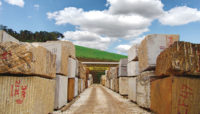
A. Lacroix et Fils Granit Ltée has made a number of technological advances at its plant in Saint-Sébastien, Québec, Canada. One of the most recent investments has been a Polywire 32 multi-wire saw from Pellegrini Meccanica of Italy, which is used to process blocks into raw slabs.
Nestled among the pine-covered hills of Saint-Sébastien in Québec, Canada, A. Lacroix et Fils Granit Ltée processes stone with advanced stoneworking machinery that is being updated on a continual basis. Operating with a dedicated staff of experienced workers, the family-run company has invested in the latest generation of technology for slab production as well as custom architectural stonework.

According to the firm, the unit does the work of several gangsaws. Blocks are fed to the saw by means of a trolley.
Slab and tile production
The centerpiece of the company’s slab production is a Polywire 32 multi-wire saw from Pellegrini Meccanica of Italy, which is used to process blocks into raw slabs. According to the firm, the unit does the work of several gangsaws, and the foundation is a fraction of the cost of a gangsaw. “This will be our future,” said Simon Lacroix, the company’s vice president.The saw can cut slabs ranging from 2 to 5 cm in thickness, and A. Lacroix currently has the unit set up for 3-cm slab material. When processing material of this size, A. Lacroix equips the saw with 22 wires.
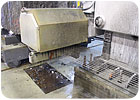
A. Lacroix credited Diamant Boart for developing the optimum diamond wire for use with the machine.
He credited Diamant Boart for developing the optimum diamond wire for the machine. “They have come up with a very good endless wire,” he said, adding that the precision of the wire allows them to recover an extra one or two slabs per block processed.
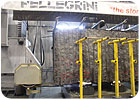
In terms of production speed, the saw can process a block into raw slabs in four to four and a half hours.
A. Lacroix did a great deal of research before making the investment in this new technology. “We were balancing the investment and the payback, and we were also looking at our long-term production,” Simon Lacroix said.
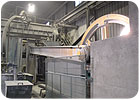
The company also has seven gangsaws, including a Masterbreton HG from Breton.
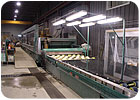
Slabs are polished on a Levibreton polishing line with 19 polishing heads.
Slabs are polished on a Levibreton polishing line with 19 polishing heads. On average, A. Lacroix has a polishing capacity of 1,500 square feet per hour.

As needed or by request, A. Lacroix also has automated machinery for resin treatment of slabs. This includes driers from Protec that can house 60 slabs at one time.
In general, though, A. Lacroix only treats 5 to 10% of its slab material with resin, using the process on materials such as Atlantic Black or Orion, which have surface fissures. “They are not structurally poor, but [resin treatment] enhances the look,” Simon Lacroix explained.
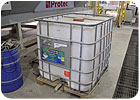
Resin products are supplied by Tenax.
Slab and tile production is mainly comprised of material from A. Lacroix’s own quarries, in addition to some U.S. granite varieties such as Deer Isle, Kershaw, Dakota Mahogany, etc.
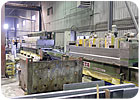
The production is carried out using a Zambon tile line. Although not a major component of the company's business, A. Lacroix invested in the machinery to satisfy the needs of its existing customer base, rather than subcontract the tile fabrication.
Architectural work
In addition to investments in slab production, A. Lacroix is also continually updating its machinery in the cut-to-size end of the business. This includes a multi-head saw from Breton that can automatically execute a broad range of specific cuts on a workpiece. After the unit is pre-programmed with the desired sizes of the project, the workpiece moves to the cutting heads via conveyor and the initial cuts are made. The piece then leaves the cutting area, is automatically repositioned, and then returns to the blades for further cutting as needed.
A. Lacroix is also continually updating its machinery in the cut-to-size end of the business. This includes a multi-head saw from Breton that can automatically execute a broad range of specific cuts on a workpiece.
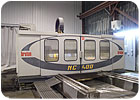
A Contourbreton NC 400 CNC multi-axis stoneworking center from Breton is also among hte advanced equipment used for cut-to-size work, including countertops that A. Lacroix fabricates for outside installers on a contract basis.
For three-dimensional work, Lacroix has a range of advanced machinery. When processing large-scale pieces of this type, one of the key pieces of equipment is a Pellegrini Robot Wire saw, which can be programmed to make a range of intricate, complex cuts. The company also re-engineered a 7-axis Fanuc unit for three-dimensional stoneworking, and it has become a vital piece of machinery for custom stonework.
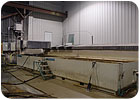
A Flow waterjet for custom production also features a double worktable, allowing for faster production and less downtime.
In terms of surface finishing, the company invested in a line that is capable of flaming, waterjet finishing and sandblasting. When processing material on this line, the company will often use combinations of the three different surface finishes. “The waterjet finishing brings out the color, especially in darker materials,” Simon Lacroix said. “The pearls also flash.”
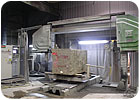
When processing large-scale cubic work, one of the key pieces of equipment is a Pellegrini Robot Wire saw, which can be programmed to make a range of intricate, complex cuts.
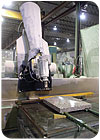
The company also re-engineered a 7-axis Fanuc unit for three-dimensional stoneworking.
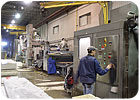
A. Lacroix also invested in a line that is capable of flaming, waterjet finishing and sandblasting, and materials are often finished using a combination of these methods.
Only about one-third to one-half of A. Lacroix’s architectural work is done in its own granites. Because it works on many government projects in America, much of the work tends to be completed in U.S. granites, as well as materials like Vermont marble and Indiana limestone.
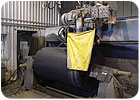
For columns and other circular work, stone is processed on a large-scale lathe.
Company history and structure
A. Lacroix was founded in 1962 by Armand Lacroix and four of his sons, and the company has remained a family-owned business over the decades. Claude Lacroix is the company president and owner, and he is joined in the business by three of his children. Simon Lacroix is vice president; Fréderic Lacroix is secretary-treasurer; and Dominique Lacroix is director.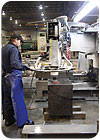
Thibaut T108 polishers are also used when processing architectural pieces.
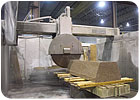
Custom cutting is completed using a variety of bridge saws.

The company has been fabricating more limestone over the past year, including a great deal of radius and curved work.

A vast amount of finished products are on hand, ready for shipment.
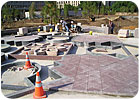
The First Lady Garden in Washington, DC, is among the company’s recently completed architectural projects.
